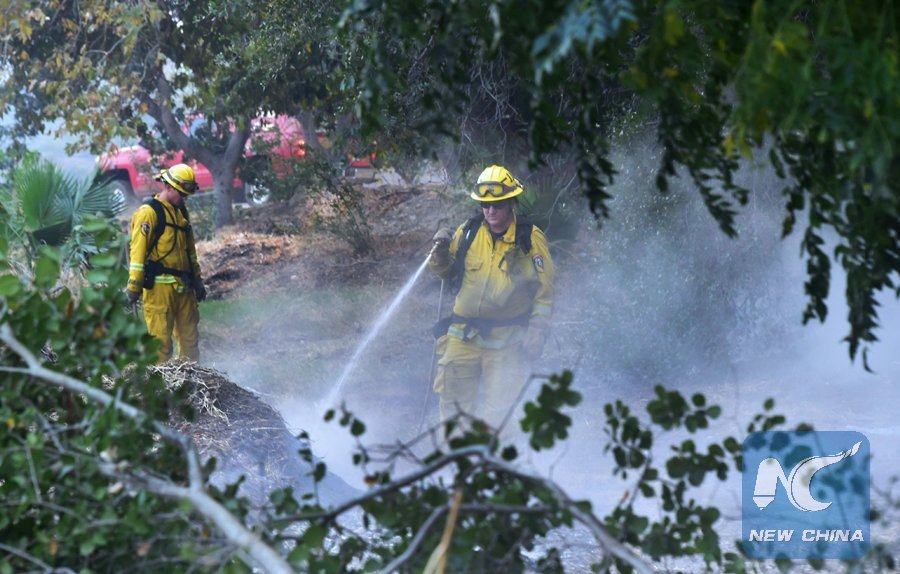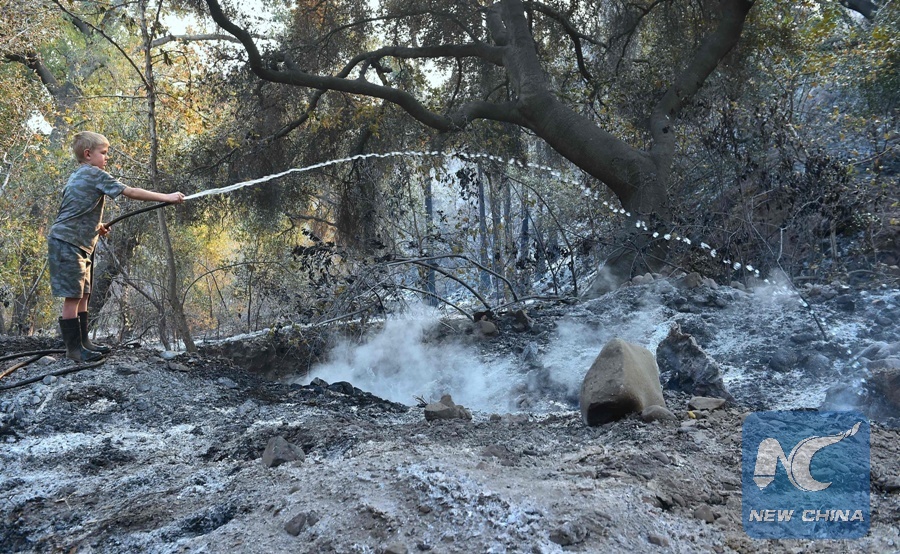
Firefighters water down the burning embers from an overnight fire near a home in Fillmore, California on December 15, 2017. (Xinhua/AFP PHOTO)
LOS ANGELES, Dec. 16 (Xinhua) -- The ferocious wildfire raging in the U.S. state of California for nearly two weeks grew more volatile on Saturday, threatening a wealthy community northwest of Los Angeles and prompting new evacuation orders in Santa Barbara County.
The Thomas Fire, now ranked the third largest wildfire in modern history of California, was moving rapidly and now took aim at the hills above the unincorporated Santa Barbara County community of Montecito known for its luxury resorts and mansions of celebrities.
Under Saturday's orders, the evacuation zone for Thomas Fire has been expanded to 17 miles (28.9 kilometers) long and 5 miles (8.5 kilometers) wide.
Taking advantage of a lull in winds in last Wednesday to Friday, firefighters cleared contained areas along the westernmost edge of the giant blaze to stop the wildfire from approaching communities at foothills, Tony Pighetti, a captain of the Santa Barbara fire department, told Xinhua.
However, fueled by a new blast of Santa Ana winds which were predicted to hit the area through Sunday with gusts of 65 mph (110 kph), the Thomas Fire moved northward fast Saturday and the flame has been seen on top of hill over the town.
Kelly Hoover, Santa Barbara County Sheriff's spokeswoman, said that authorities dispatched hundreds of crews to Montecito, checking the communities door to door and ordering residents to leave the evacuation zone.
She warned that the situation was really dangerous for their lives since the Santa Ana winds mixed with the Sundowner, a northerly offshore wind in Santa Barbara.
"When the sundowners surface in that area and the fire starts running down slopes, you are not going to stop it," Mark Brown, an operations section chief for the California Department of Forestry and Fire Protection (Cal Fire), told reporters at a news briefing on Saturday morning.
"And we are not going to stand in front of it and put firefighters in untenable situations," he added.
A sundowner is particularly dangerous during wildfire season because the air heats and dries as it descends from the mountains to the sea.

Kyle Cox, 7, uses a hose to water down the burning embers from an overnight fire near his home in Fillmore, California on December 15, 2017. (Xinhua/AFP PHOTO)
Pictures posted on Twitter showed that platoons of fire trucks awaited orders with their engines running in parking lots of public schools, churches and other designated safety zones Saturday morning.
Santa Barbara branch of Cal Fire tweeted a video at noon, showing fire engines from Portland of Oregon state provided structure protection at the historic San Ysidro Ranch in Montecito, a luxury resort dated from 1893.
Montecito, a small oceanside city located between the Coastal Mountains and the Pacific seashore with about 20,000 residents, were empty since from last week the fire scorched the southern Ventura County.
The Santa Ana winds are strong, extremely dry down-slope winds that originate inland and affect coastal Southern California in fall and winter. They are known as "devil winds" for fanning regional wildfires.
Fanned by the unusual Santa Ana this winter, the Thomas Fire has scorched about 259,000 acres, destroyed 1,000 structures and killed two people including a firefighter in Southern California since it ignited on Dec. 4.
In Cal Fire's list of the top 20 largest wildfires in the state dates back to 1932, only two fires have burned more acreage in California so far this century: the Cedar Fire of 2003, and the Rush Fire of 2012, which burned 273,246 and 271,911, respectively.
A 32-year-old firefighter from San Diego county died Thursday from burns and smoke inhalation, according to autopsy results announced Saturday by the Ventura County medical examiner's office.
National Weather Service meteorologist Curt Kaplan was quoted by ABC news channel as saying that they never seen the red flag warnings were issued for straight 12 days before.
"This has been the longest duration event that we have had a red flag warning out without any breaks," he said.
Red flag warnings were instituted by the weather service in 2004 and are intended to alert fire agencies to hot, dry and windy conditions that foster wildfires.
The National Weather Service warned that red flag conditions would be in effect in the Santa Barbara County mountains till Sunday morning.
To contain the Thomas Fire, about 8,300 firefighters from nearly a dozen states have been battling on fire lines for 13 days, aided by 78 bulldozers and 29 helicopters. And the firefighting costs approached 89 million U.S. dollars.

